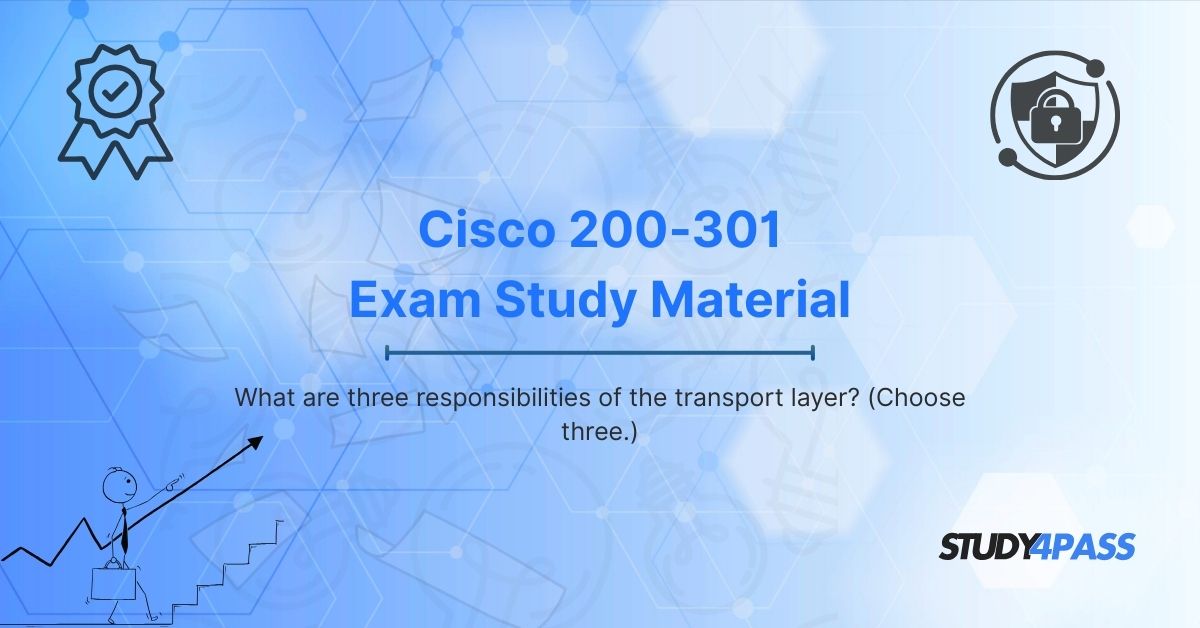Introduction
The Transport Layer is a crucial component of the OSI (Open Systems Interconnection) model, playing a vital role in ensuring reliable communication between devices over a network. For aspiring networking professionals preparing for certifications like CCNA, CCDA, CCENT, CCNA Security, and CCNA Wireless, understanding the Transport Layer's responsibilities is essential.
This article explores three primary responsibilities of the Transport Layer in detail, providing insights that align with the Cisco 200-301 exam objectives. Additionally, we recommend Study4Pass as an excellent resource for mastering these concepts through structured study materials, practice exams, and expert guidance.
End-to-End Communication and Segmentation
What is Segmentation?
The Transport Layer breaks down large chunks of data received from the upper layers (Session Layer or Application Layer) into smaller, manageable units called segments (in TCP) or datagrams (in UDP). This process ensures efficient data transmission across the network.
Why is Segmentation Important?
- Prevents Network Congestion: Large data packets can overwhelm network resources, leading to delays. Segmentation helps distribute data evenly.
- Improves Reliability: Smaller segments reduce the chances of errors during transmission. If an error occurs, only the affected segment needs retransmission.
- Supports Multiplexing: Multiple applications can share the same network connection by interleaving their segments.
Relevance to CCNA 200-301 Exam
Cisco emphasizes understanding how TCP and UDP handle segmentation differently. Study4Pass provides in-depth explanations and practice questions to reinforce this concept.
Connection Establishment, Maintenance, and Termination (TCP Only)
The Three-Way Handshake
The Transport Layer ensures reliable communication using Transmission Control Protocol (TCP), which establishes a connection through a three-way handshake:
- SYN – The sender initiates a connection by sending a synchronization packet.
- SYN-ACK – The receiver acknowledges the request and sends its own synchronization packet.
- ACK – The sender confirms the connection, and data transfer begins.
Connection Termination
TCP also ensures proper session termination using a four-way handshake (FIN, ACK, FIN, ACK).
Why is Connection Management Important?
- Guarantees Data Delivery: Ensures all packets reach the destination in the correct order.
- Prevents Data Loss: Retransmits lost packets automatically.
- Optimizes Network Resources: Proper termination frees up network resources.
Study4Pass Advantage
For CCNA aspirants, mastering TCP mechanisms is critical. Study4Pass offers interactive labs and real-world scenarios to help students grasp these concepts effectively.
Flow Control and Error Handling
Flow Control Mechanisms
The Transport Layer regulates data flow to prevent overwhelming the receiver using:
- Sliding Window Protocol – Adjusts the transmission rate based on receiver capacity.
- Congestion Avoidance – Reduces transmission speed if network congestion is detected.
Error Detection and Correction
- Checksums – Verify data integrity by detecting corrupted segments.
- Acknowledgments (ACKs) and Retransmissions – Ensure lost or corrupted packets are resent.
Why is Flow Control and Error Handling Important?
- Enhances Network Efficiency: Prevents bottlenecks and ensures smooth data transfer.
- Improves User Experience: Minimizes delays and data corruption.
How Study4Pass Helps?
Study4Pass provides detailed study guides and quizzes on Transport Layer protocols, helping students understand flow control and error handling mechanisms for the CCNA Exam.
Conclusion
The Transport Layer is indispensable for reliable network communication, with its three key responsibilities:
- Segmentation of data for efficient transmission.
- Connection management (TCP) to ensure reliable communication.
- Flow control and error handling to optimize performance.
For those preparing for Cisco 200-301 (CCNA), CCDA, CCENT, CCNA Security, or CCNA Wireless, mastering these concepts is crucial. Study4Pass stands out as an excellent study resource, offering comprehensive materials, practice tests, and expert guidance to help you succeed in your certification journey.
Visit Study4Pass today to access high-quality CCNA study materials and boost your networking career!
Special Discount: Offer Valid For Limited Time “200-301 Study Material”
Actual Exam Questions For Cisco's 200-301 Mock Test
Sample Questions For Cisco 200-301 Exam
1. Which of the following is a responsibility of the transport layer?
A) Routing packets between networks
B) Error detection and recovery
C) Encrypting data for security
D) Defining physical cable connections
2. What is one of the key functions of the transport layer in the OSI model?
A) Assigning IP addresses to devices
B) Ensuring reliable end-to-end data delivery
C) Converting data into electrical signals
D) Managing MAC address assignments
3. Which of the following is NOT a responsibility of the transport layer?
A) Flow control
B) Segmentation and reassembly
C) Logical addressing
D) Connection establishment and termination
4. The transport layer is responsible for:
A) Transmitting data over physical media
B) Providing process-to-process communication
C) Assigning domain names to servers
D) Controlling access to the network
5. Which transport layer protocol ensures reliable, ordered, and error-checked delivery?
A) UDP
B) IP
C) TCP
D) ICMP


